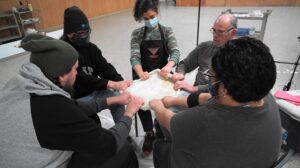Crafters learn a valuable lesson in hide-tanning

By Colin Graf
DESHKAN ZIIBING (CHIPPEWAS OF THE THAMES FIRST NATION)— Community members of Chippewas of the Thames First Nation (COTTFN) have had a unique opportunity to learn about the traditional ways of tanning and preparing deer hide while also creating a new tool to help with learning their ancestral language.
A small group of crafters and others interested in hide-tanning joined members of the COTTFN Language, Culture, and Heritage Department at a week-long event in the community in Dec., says Elijah Jewell, language resource technician.
The hide-tanning day camp taught participants first how to soak the new hides in water and hardwood ash to loosen the hair and membranes next to the skin, and then stretch it on wooden frames, Jewell explains. The event was run by Barry Callow, an avid outdoorsman from the region, described by Jewell as a “strong ally and good friend” to the COTTFN community.
Callow, who has been doing classes on hide-tanning for three different First Nations in the London area for years, says the COTTFN event was one of the best yet due to the enthusiasm of the participants.
“They were very energetic; they wouldn’t even let me sit down and have a coffee,” Callow says laughingly. “Nobody complained about the type of work that went into preparing the hides, not even when they learned what came after the hides are removed from the watery ash buckets, scraped clean on both sides, and stretched on wooden drying racks.”
That next step is mixing the animals’ brains in hot water to make an overnight bath for the hides. Testing the mettle of his students, Callow was pleased that
“Nobody went, ‘Oh God, brains, yuck,’” Callow enthusiastically reports. “[They] got right into it.”
Some shortcuts were taken, he admits. The brains were mixed in a blender but you “can get your hands in there and smush it all up.”
Callow decided years ago that he wanted to help rejuvenate the old ways of treating hides after seeing so many chemically-treated skins on drums, clothing, and crafts “from moccasins to medicine bags, you name it.” Callow has made it a personal mission to help teach the ways he learned from books that documented the old ways and by trial-and-error with hides as a young man.
The number of students was small, as COVID-19 pandemic regulations only allowed 10 people to be together, Jewell recalls.
As the event took place before the current lockdown, Jewell was able to film the tanning classes, and will be using the footage to make a video that will have narration added in English with some Anishinaabemowin and then shared on COTTFN social media platforms and possibly further afield.
Jewell and his supervisors thought the tanning camp would be a good way to provide language learning, especially considering it’s “a traditional practice” that is linked to “living in relationship to the land.” While the short film will not be primarily a how-to on deer hide-tanning, Jewell admits that ”if you happen to have a fresh deer hide, then this would be a good video for you.” He hopes the production will be ready within a few weeks.
The learners at the pre-Christmas class worked on the hides for five to six hours every day for a week, Jewell says, and were very eager. One woman brought in a hide she had tanned herself and “totally loved” the classes,” according to Jewell. While Callow brought one or two hides initially, the group was so motivated that they finished three or four hides before the end of the camp, Jewell says. While there are “quite a few hunters” in COTTFN, Jewell says the class wasn’t dominated by that group at all.
After the brain bath, the pure white hides were ready for smoking over a fire of “punk”, or rotted, wood to give them colour, a process put off until spring because of weather problems, Callow says.
Brain-tanned hides are very different from chemically-treated ones, he says, creating a better quality product. A couple of instructors at the recent camp told Callow that craftworkers at powwows have said it takes 10 times the effort to stitch a commercial hide compared to a brain-tanned one, he says. Hides prepared in the old way “last almost forever,” he adds, and when smoked, they are also “basically waterproof”.
One student at the camp has already sold around five hides she has prepared, Callow states. He helped her find the hides, although that is not usually very hard as deer hunters usually want rid of the hides, and butchers do not have a need for them either. Some are sent to a facility near Toronto for commercial tanning, but as for most hunters and butchers, “those guys just want the hides off, that’s all they want,” Callow notes.


